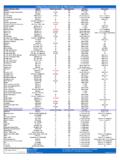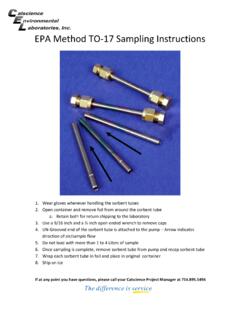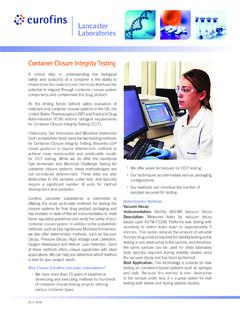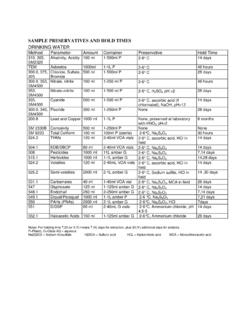Transcription of AN INTRODUCTION TO THE ENVIRONMENTAL …
1 Calscience ENVIRONMENTAL Laboratories, Inc. AN INTRODUCTION TO THE ENVIRONMENTAL LABORATORY ENVIRONMENTAL , Air & Marine Chemistry 1 WELCOME TO CALSCIENCE ENVIRONMENTAL LABORATORIES, INC. Founded in 1986, Calscience ENVIRONMENTAL Laboratories, Inc. is an industry leader in the ENVIRONMENTAL laboratory testing field. We provide quality analytical services to consultants, private industry and government agencies. Calscience offers a comprehensive portfolio of analytical methods and our analytical expertise encompasses all ENVIRONMENTAL matrices including air, groundwater, marine sediment, soil, solid waste, and wastewater. We are a customer-focused organization whose goal is to meet or exceed the expectations of our customers in terms of quality and service. It is through the quality of our service and the loyalty of our clients, that Calscience has grown to become one of the largest ENVIRONMENTAL testing laboratories in California.
2 Our Vision and Mission Calscience ENVIRONMENTAL Laboratories is dedicated to providing our clientele a competitive advantage by the routine provision of litigation quality analytical data. Achievement is attained through a continual process of quality improvement and advancement in all areas of our performance. Calscience focuses on servicing the ENVIRONMENTAL engineering community, not only to provide reliable data, but to help our customers meet their goals in terms of project profitability and timely completion. Our customers know that Calscience, more than any other laboratory, will allow them to run their projects more efficiently, save labor hours, and provide data and information when they need it and how they need it. Stability, integrity, and service; these are but a few of the reasons Calscience is valued by our clients and why they keep coming back.
3 Who We Serve Our clients come from a diverse range of consultants, private industry, and federal, state, and local governments. With a strong industry reputation, we provide contract analytical services to Fortune 100 Companies. Our services support various industries and project types including: School Districts Real Estate Refineries Landfills Oil and Gas Utilities Ports Treatment Facilities Petrochemical Department of Defense City, County, State Agencies Chemical Industry Aerospace Industry Entertainment/Movie Studios Railroads TABLE OF CONTENTS INTRODUCTION 1 SAMPLE RECEIVING 1 Chain of Custody 1 Responsibilities and Procedures 2 ANALYTICAL APPROACHES 3 Gas Chromatography 3 Detectors 4 Mass Spectrometer (MS)
4 5 Liquid Chromatography 6 High Performance Liquid Chromatography 6 Ion Chromatography 6 Inductively Coupled Plasma Atomic Emission Spectrometry / MS 6 General Wet Chemistry Techniques 7 pH Power of Hydrogen 7 Alkalinity 7 BOD - Biochemical Oxygen Demand 8 Specific Conductance 8 TOC - Total Organic Carbon 8 TDS - Total Dissolved Solids 8 TSS - Total Suspended Solids 8 Extraction and Preparation Techniques 9 EPA 3550 Sonication 9 EPA 3540 - Soxhlet Extraction 9 EPA 3545 - Pressurized Fluid Extraction (PFE) 10 EPA 3510 Separatory Funnel Extraction 10 EPA 3520 Liquid-Liquid Extraction 10 EPA 3005 Acid Digestion for Surface or Ground Waters 10 EPA 3010 / 3020 Acid Digestion of Aqueous samples 11 EPA 3050 Acid digestion of Soils, Sediments, Sludges 11 TCLP - Toxicity Characteristic Leaching Procedure 11 STLC - Soluble Threshold Limit Concentration ( WET ) 12 TABLE OF CONTENTS, Cont d QUALITY CONTROL 12 Quality Control samples and Requirements 13 Sample Batching 13 Blanks 14 Laboratory Control samples (LCS) 14 Matrix Spike/Matrix Spike Duplicate samples (MS/MSD)
5 15 Surrogates 16 Holding Times 16 Standards and Reagents 16 Additional Quality Control samples 17 Detection Limits 17 Method Detection Limits 17 Reporting Limits 17 Dilutions Raising the RL and MDL 18 Calibration and Calibration Verification 18 Initial Calibration (ICAL) 18 Curve Fitting 20 Linear Calibration using Calibration or Response Factors 21 Linear Calibration using Least Squares Regression 21 Coefficient of Determination (r2 or Quadratic) 22 Initial Calibration Verification (ICV) 22 Continuing Calibration Verification (CCV) 23 GC/MS Tuning 25 Data Integrity and Ethics 25 Manual Integration 26 Data Review 26 Bench Level Review 26 Second Level Review 27 Completeness Review 27 PROJECT MANAGEMENT 27 HEALTH AND SAFETY 27 TERMS AND DEFINITIONS 28 REFERENCES AND SOURCES 37 Calscience ENVIRONMENTAL Laboratories, Inc.
6 INTRODUCTION The purpose of this manual is to provide a general overview of the processes and procedures at Calscience. The objective is to help employees understand the different operational areas of the laboratory and to highlight their importance in the analytical chain-of-custody. The laboratory is divided into several operational groups; Sample Receiving and Disposal, Volatile Organics, Semivolatile Organics, LUFT, Air, Metals, Wet Chemistry and Project Management. Each of these groups works in concert with the other to produce legally-defensible analytical data of known quality while meeting the clients needs. The following sections will focus on the flow of samples through the lab areas, general analytical approach and theory, instrumentation types and key terms used in the lab. SAMPLE RECEIVING The first step in the laboratory process is sample receiving.
7 It is here that samples are received, reconciled against a Chain-of-Custody (COC), labeled and stored for processing by the lab. Chain of Custody (COC) samples are received from many different sources; shipped to Calscience via commercial carriers (FedEx, GSO, etc.), through personal delivery of samples by the clients, or by Calscience couriers picking them up from the field. Once received by the laboratory they are checked against the COC for anomalies/discrepancies, labeled, logged into the LIMS system and stored under appropriate conditions for further processing by the analytical departments. The process of receiving samples begins with the COC. samples should be submitted to the laboratory under standard chain-of-custody procedures and the COC should be completed in full by field personnel. The COC is used to document all aspects of sample handling. It contains information pertaining to the client, the laboratory, the sampler, the project, the samples and their ID s, sample collection dates and times, containers and preservatives, analyses requested, turn around time required and any potential hazards or other pertinent information related to the samples , sampling event, or reporting format.
8 At its most basic, the COC is a legal document that presents an unbroken trail of accountability that ensures the physical security of samples , data and records. It allows the samples to be tracked from the field to the lab, and through the use of internal COC s, throughout the lab to disposal. Because of this, it is probably the single most important item, aside from the samples themselves, of the receiving process. An example of a typical COC is pictured on the following page. 1 Calscience ENVIRONMENTAL Laboratories, Inc. Responsibilities and Procedures samples are accepted at the laboratory by the Sample Receiving Group. The primary responsibilities of the Sample Receiving Group are as follows: Receive samples on behalf of Calscience and sign custody documents Unpack coolers, check temperatures, and remove/organize the samples per the COC Check the COC documents against the actual samples Check for proper sample containers, volumes and preservation Check for accelerated turn around times and short holding time analyses Complete sample receipt and anomaly documentation Place into and remove samples from refrigerated storage 2 Calscience ENVIRONMENTAL Laboratories, Inc.
9 Upon receipt, the COC is signed and dated and the sample receiving personnel visually inspect the cooler for custody seals and any obvious damage. They then open and inspect the contents of the cooler and take the cooler temperature via an IR thermometer. (The temperature upon receipt is a critical item and, for most soils and water methods, should be between >0oC and 6oC) A Sample Receipt Form (SRF) is initiated to record the following: client, number of coolers, Calscience Work Order number, date, temperature, custody seal/sample integrity, COC integrity, sampler information, sample labels, container integrity, holding time integrity, preservative and VOC container integrity (headspace). The form is also be used to record container type received. All documents are inspected to assure agreement between the samples received and the COC. Any discrepancy, irregularity, or compromised sample is noted on a Sample Anomaly Form (SAF) and brought to the attention of the Calscience Project Manager (PM) for resolution with the client.
10 The COC, SRF, SAF (if used), record of client contact, and resulting instructions all become part of the project record. Once the samples have been reconciled against the COC and a Work Order Number has been assigned, the samples are labeled and placed in the appropriate storage refrigerator until retrieved by the lab for preparation and analysis. The lab personnel retrieve the samples and, when required by project or client specifications, complete an internal chain of custody (ICOC) to track sample movement throughout the lab. After analysis the samples are returned to the appropriate refrigerator where they are maintained for 30 days. After 30 days the samples are moved to ambient storage where they are maintained for up to an additional 30 days, possibly longer depending on project requirements, and then properly disposed of. ANALYTICAL APPROACHES samples may be analyzed for one or more organic or inorganic constituents.










